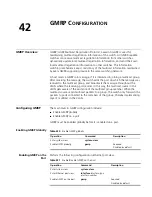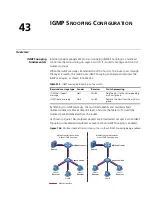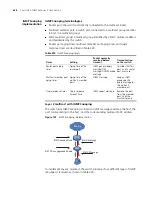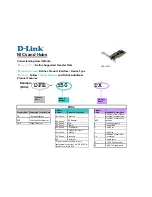
Multicast Architecture
417
■
Multicast routing: How is information transported?
IP multicast is a kind of peer-to-peer service. Based on the protocol layer sequence
from bottom to top, the multicast mechanism contains addressing mechanism,
host registration, multicast routing, and multicast application:
■
Addressing mechanism: Information is sent from a multicast source to a group
of receivers through multicast addresses.
■
Host registration: A receiving host joins and leaves a multicast group
dynamically to implement membership registration.
■
Multicast routing: A router or switch establishes a packet distribution tree and
transports packets from a multicast source to receivers.
■
Multicast application: A multicast source must support multicast applications,
such as video conferencing. The TCP/IP protocol stack must support the
function of sending and receiving multicast information.
Multicast Address
As receivers are multiple hosts in a multicast group, you should be concerned
about the following questions:
■
What destination should the information source send the information to in the
multicast mode?
■
How to select the destination address, that is, how does the information source
know who the user is?
These questions are about multicast addressing. To enable the communication
between the information source and members of a multicast group (a group of
information receivers), network-layer multicast addresses, namely, IP multicast
addresses must be provided. In addition, a technology must be available to map IP
multicast addresses to link-layer MAC multicast addresses. The following sections
describe these two types of multicast addresses:
IP multicast address
Internet Assigned Numbers Authority (IANA) categorizes IP addresses into five
classes: A, B, C, D, and E. Unicast packets use IP addresses of Class A, B, and C
based on network scales. Class D IP addresses are used as destination addresses of
multicast packets. Class D address must not appear in the IP address field of a
source IP address of IP packets. Class E IP addresses are reserved for future use.
In unicast data transport, a data packet is transported hop by hop from the source
address to the destination address. In an IP multicast environment, there are a
group of destination addresses (called group address), rather than one address. All
the receivers join a group. Once they join the group, the data sent to this group of
addresses starts to be transported to the receivers. All the members in this group
can receive the data packets. This group is a multicast group.
A multicast group has the following characteristics:
■
The membership of a group is dynamic. A host can join and leave a multicast
group at any time.
■
A multicast group can be either permanent or temporary.
Summary of Contents for Switch 7757
Page 32: ...32 CHAPTER 1 CLI OVERVIEW...
Page 70: ...70 CHAPTER 5 LOGGING IN USING MODEM...
Page 76: ...76 CHAPTER 7 LOGGING IN THROUGH NMS...
Page 86: ...86 CHAPTER 9 CONFIGURATION FILE MANAGEMENT...
Page 120: ...120 CHAPTER 13 ISOLATE USER VLAN CONFIGURATION...
Page 126: ...126 CHAPTER 14 SUPER VLAN...
Page 136: ...136 CHAPTER 16 IP PERFORMANCE CONFIGURATION...
Page 152: ...152 CHAPTER 17 IPX CONFIGURATION...
Page 164: ...164 CHAPTER 19 QINQ CONFIGURATION...
Page 172: ...172 CHAPTER 21 SHARED VLAN CONFIGURATION...
Page 182: ...182 CHAPTER 22 PORT BASIC CONFIGURATION...
Page 198: ...198 CHAPTER 24 PORT ISOLATION CONFIGURATION...
Page 208: ...208 CHAPTER 25 PORT SECURITY CONFIGURATION...
Page 224: ...224 CHAPTER 27 DLDP CONFIGURATION...
Page 232: ...232 CHAPTER 28 MAC ADDRESS TABLE MANAGEMENT...
Page 240: ...240 CHAPTER 29 CENTRALIZED MAC ADDRESS AUTHENTICATION CONFIGURATION...
Page 280: ...280 CHAPTER 30 MSTP CONFIGURATION...
Page 348: ...348 CHAPTER 35 IS IS CONFIGURATION...
Page 408: ...408 CHAPTER 39 802 1X CONFIGURATION...
Page 412: ...412 CHAPTER 40 HABP CONFIGURATION...
Page 422: ...422 CHAPTER 41 MULTICAST OVERVIEW...
Page 426: ...426 CHAPTER 42 GMRP CONFIGURATION...
Page 480: ...480 CHAPTER 47 PIM CONFIGURATION...
Page 506: ...506 CHAPTER 48 MSDP CONFIGURATION...
Page 552: ...552 CHAPTER 51 TRAFFIC ACCOUNTING CONFIGURATION...
Page 570: ...570 CHAPTER 53 HA CONFIGURATION...
Page 582: ...582 CHAPTER 54 ARP CONFIGURATION SwitchA arp protective down recover interval 200...
Page 622: ...622 CHAPTER 58 DHCP RELAY AGENT CONFIGURATION...
Page 684: ...684 CHAPTER 61 QOS CONFIGURATION...
Page 718: ...718 CHAPTER 63 CLUSTER...
Page 738: ...738 CHAPTER 67 UDP HELPER CONFIGURATION...
Page 752: ...752 CHAPTER 69 RMON CONFIGURATION...
Page 772: ...772 CHAPTER 70 NTP CONFIGURATION...
Page 796: ...796 CHAPTER 72 FILE SYSTEM MANAGEMENT...
Page 802: ...802 CHAPTER 73 BIMS CONFIGURATION...
Page 814: ...814 CHAPTER 74 FTP AND TFTP CONFIGURATION...
Page 830: ...830 CHAPTER 75 INFORMATION CENTER...
Page 836: ...836 CHAPTER 76 DNS CONFIGURATION...
Page 852: ...852 CHAPTER 77 BOOTROM AND HOST SOFTWARE LOADING...
Page 858: ...858 CHAPTER 78 BASIC SYSTEM CONFIGURATION DEBUGGING...
















































